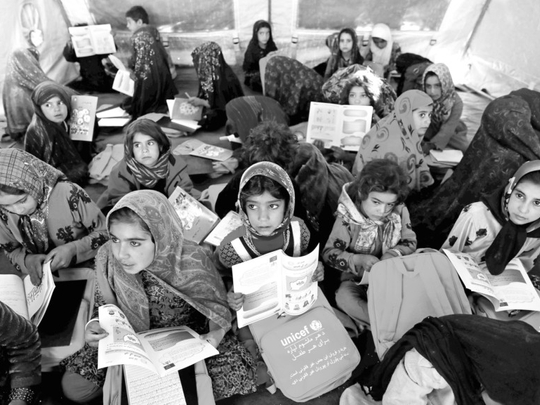
The number of migrant and refugee children in the world today could fill more than half a million classrooms. Their parents are perhaps seeking new opportunities in the city, or even in another country. Others are forced to flee conflict or natural disaster. In all, there has been a 26 per cent increase in children on the move since 2000.
These children have the right to education, no matter where they are from and what they have been through. This is the focus of our new Global Education Monitoring (GEM) Report. Migrants, refugees and internally displaced people are also some of the most vulnerable in the world. Sometimes being in school simply means being safe. Eight year-old Jana, a Syrian refugee at the Unesco-run school in the Zaatari refugee camp, Jordan, says that she felt happy just to escape the sound of gunfire. School has also given her hope; she wants to be a schoolteacher when she grows up.

When possible, these children should be placed in the same schools with host populations to help them thrive. Teachers are on the front line supporting pupils who face discrimination, or are suffering from trauma. They too need support in order to manage multilingual, multicultural classes and those suffering the psychological consequences of what they have endured.
A well-designed curriculum that challenges prejudices is also vital, and can have a positive ripple effect beyond the classroom walls, enhancing social cohesion.
Unfortunately, some textbooks include outdated depictions of migration and undermine efforts towards inclusion.
Adults also need educational support. Many have educational qualifications, but in Europe and North America, only around one in ten of those who have gained a higher education degree work in a job that matches their skills. The Unesco Global Convention on the Recognition of Higher Education Qualifications, due to be adopted next year aims to resolve this problem.
Woefully inadequate
The cost of educating immigrants is often exaggerated. Financing for refugee education, however, is currently woefully inadequate — only one-third of the funding gap for refugee education has been filled. It is a collective responsibility to ensure development aid plugs the hole, providing predictable and long-term funding so the burden does not fall on countries that are least able to cope.
The world is poised to adopt the Global Compact for Safe, Orderly and Regular Migration and the Global Compact on Refugees, both of which highlight the crucial role of education and reaffirm the importance of “leaving no one behind”. This year’s GEM Report offers a blueprint for countries to deliver on their promises. We hope all governments will use it to turn despair into hope for a brighter future for all.
Audrey Azoulay is director-general of the United Nations Educational, Scientific and Cultural Organisation (Unesco).







